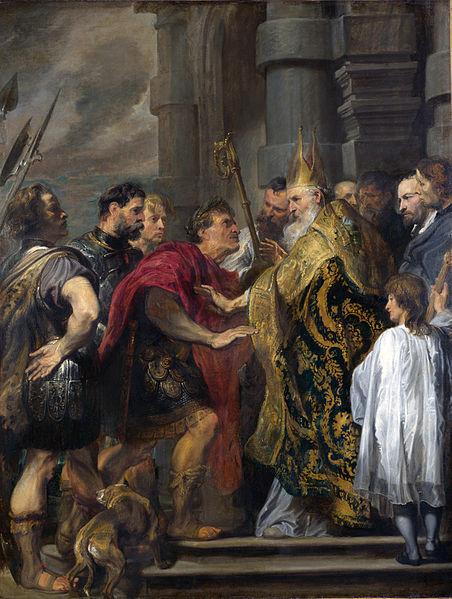Gervasius and Protasius are venerated as Christian martyrs, probably of the 2nd century. They are the patron saints of Milan and of haymakers and are invoked for the discovery of thieves. Their feast day in the Latin Rite of the Catholic Church is 19 June, the day marking the translation of their relics. In the Eastern Orthodox Church and in the Eastern Rites of the Catholic Church, their feast takes place on 14 October (O.S.)/24 October (N.S.), the traditional day of their death. In Christian iconography their emblems are the scourge, the club and the sword.
"The martyrdom of Saints Gervase and Protase," from a 14th-century manuscript.
Gervasius and Protasius, by Philippe de Champaigne
The crypt in Sant'Ambrogio basilica. Embossed silver urn, displaying the skeletons of Saints Ambrose, Gervase, and Protase.
Martyr Gervasius. Mosaic in the Basilica of San Vitale, Ravenna
Ambrose of Milan, venerated as Saint Ambrose, was a theologian and statesman who served as Bishop of Milan from 374 to 397. He expressed himself prominently as a public figure, fiercely promoting Roman Christianity against Arianism and paganism. He left a substantial collection of writings, of which the best known include the ethical commentary De officiis ministrorum (377–391), and the exegetical Exameron (386–390). His preachings, his actions and his literary works, in addition to his innovative musical hymnography, made him one of the most influential ecclesiastical figures of the 4th century.
Detail from possibly contemporary mosaic (c. 380–500) of Ambrose in the Basilica of Sant'Ambrogio
Relief by Vuolvino [it] depicting Ambrose as a child while bees swarm his crib. His father is on the right of the image while the sky has three clouds "sending forth flames". The relief is from the Altar of Sant'Ambrogio in the Basilica of Sant'Ambrogio.
Saint Ambrose barring Theodosius from Milan Cathedral a "pious fiction" painted in 1619 by Anthony van Dyck. National Gallery, London
Embossed silver urn with the body of Ambrose (with white vestments) in the crypt of Sant'Ambrose, with the skeletons of Gervase and Protase






![Relief by Vuolvino [it] depicting Ambrose as a child while bees swarm his crib. His father is on the right of the image while the sky has three clouds](https://upload.wikimedia.org/wikipedia/commons/thumb/e/e7/Altare_di_s._ambrogio%2C_824-859_ca.%2C_retro_di_vuolvino%2C_storie_di_sant%27ambrogio_06_miracolo_delle_api.jpg/640px-Altare_di_s._ambrogio%2C_824-859_ca.%2C_retro_di_vuolvino%2C_storie_di_sant%27ambrogio_06_miracolo_delle_api.jpg)
